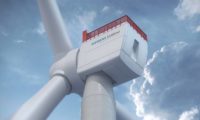Alternative Wind Turbine Technology Makes Big Claims
An energy company says its ducted wind turbine produces six times more energy than traditional, vertical turbines seen around the world. It recently announced the ability to install multiple turbines in a single unit, a first for the industry
I tried to come up with something to bring wind to the turbine and generator instead of taking the generator to the wind,” says Daryoush Allaei, founder, SheerWind Chaska, Minn. and creator of the wind turbine system he calls INVELOX. He adds that the US Department of Energy (USDOE) asked him, in 2009, to look into a wind turbine design that had no noise, radar or optical-flickering issues. “We started asking basic questions like, ‘why are turbines 20 meters in the sky and why are they so big?’” says Allaei.
Allaei and his team built a multi-directional funnel system that channels wind from 18 meters off the ground—the height of the center of the intake system—down through a tapering pipe to a Venturi section, which houses from one to three turbines at ground level. The design takes advantage of the Venturi effect—where fluid speeds up when it goes through a constricted section of pipe—to amplify and harness wind at a higher speed.
Traditional turbines require eight to 10 mph winds to start turning and they shut down at 57 mph,” says Allaei. “We have no shutdown speed and we can operate at less than 2 mph.” Allaei adds that INVELOX is also bird friendly.
Allaei says the INVELOX system (see video here) is more efficient since it can operate more often and speed up wind and implement multiple turbines. But one industry commentor claims SheerWind’s facts are unfounded.
[INVELOX] is likely generating about eighteen times less for perhaps ten times the material,” says Mike Barnard, senior fellow, Wind, at the Energy and Policy Institute, whose July 8, 2014 report damned Allaei’s computational fluid dynamics study in which his INVELOX test model was pitted against a traditional turbine.
Barnard’s beef can be boiled down to inappropriate comparisons in the SheerWind study and that its data did not support their claim of 600% more electricity generation (but instead 314% on average). His piece argues that the INEVOLOX was higher in the air (by 8 meters) and had more swept area (by 235 meters) than the opponent turbine.
They are pretending to make an apples-to-apples comparison while actually making a grapes-to-watermelon comparison,” says Barnard, in his report. When contacted, Barnard said he’d been waiting for years to point out weaknesses in the INVELOX system and Allaei’s recent report gave him enough fodder.
Barnard says he chooses to dismember technology that is detracting from proven wind power systems. When asked for a response to Barnard's accusations, Allaei responded:
"Our team has been aware of this blogger for some time," says Allaei, "He writes negatively with no supporting documents. He has done this to other technologies under development and alternative to current wind industry. Almost, it appears he is paid to discredit those technologies that are about to break through."
Barnard’s claims aside, SheerWind offers an intriguing concept, promising enough to have garnered millions in investments and national news coverage, similar to the proposed Solar Wind Energy Tower in Arizona.





